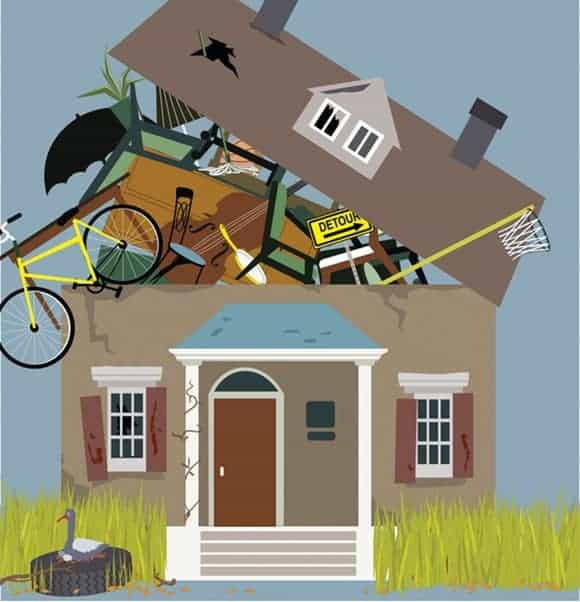
“My husband is hoarding. What can I do” is a question I get asked from time to time. You can substitute ‘husband’ with other nouns like partner, mother, father, grandmother and so on. I am a professional organizer who specializes in working with people affected by hoarding or hoarding behaviors. I often get questions from family members who want to help. Here are some tips and strategies to follow if your husband or someone you love is hoarding. (If you want to understand more about hoarding, read this article.)
Safety First for Everyone Involved
Always consider safety first. Clear hallways and the floor in general to avoid tripping hazards. If the person is older a fall could lead to complications. Ask before touching or moving anything.
You may have many ideas as to how to deal with these things that are in the way. Ask first. Never touch or move these things without asking. Always appeal to the person by explaining you are looking out for their safety.
Clear things away from doors. If piles are preventing doors from opening completely, explain to your husband, partner, or loved one that this is dangerous. You want first responders to be able to open the door completely in case of an emergency. And you want them to be able to leave quickly in case of a fire.
Try to clear things away from air vents and windows. Often, the shades are down, curtains drawn, and windows tightly shut in a home that is filled up and overflowing. We know this is to prevent people from seeing inside because, generally speaking, the person is ashamed and embarrassed however this also traps stale air inside the home.
Even if Your Husband is Hoarding, Always Ask Permission
Before you go around moving piles to clear the air vents, windows, and doorways, ask permission. Very often, people who are hoarding are sensitive about other people touching and/or moving their things. It may be because they know what is in each pile in that place. When you move or rearrange the pile you’ve disrupted the picture they hold in their mind.
Take a minute and ask. Then explain why you want to follow through with the request. If your loved-one pushes back and argues with you, back-off. You won’t win the argument. All you will do is make them distrust you.
How Do You Handle Too Much Paper?
We all know paper is combustible. Sometimes people just look for convenient places to stash paper if they are cleaning up in a hurry. No matter what, do not let your husband put paper piles in the oven. I know the oven is a big empty space, but it is not a good place to store paper. What if someone didn’t look inside before turning the oven on and, by mistake, set the house on fire because there was a huge pile of papers stored in the oven!
Think safety first. Get a couple of bankers’ boxes and suggest that your husband or loved one store their papers in the boxes instead. These boxes can be safely stacked in a corner of a room. Remember to label them so the person has a general idea of what is inside. You could also label the box according to the location you found the paper.
Very often someone who is hoarding papers thinks that every piece of paper is important to keep.
You can help by downloading some guidelines. Here is a resource from Suze Orman which tells what personal papers are important to keep and for how long. There are others, of course, but this is a good starting point. Share this resource with your husband if he is hoarding papers.
Clutter in the Bathroom
Bathrooms are also places to keep paper and other things. The bathtub and shower can hold lots of newspapers, magazines, and piles of paper not to mention, clothes.
Since we are talking about safety first, begin by talking about personal hygiene. If the bathroom is full of stuff, it can not be used as a place to clean up.
How to Talk to Your Husband about his Hoarding
One way to help is to talk about the collection of things and ask to set limits so that the two of you can live safely together in the home.
Ask if you can work together to create some rules about the variety of things being kept.
For instance: how many months (or years) to keep the magazines? Can all solicitations that come in the mail be recycled? If clothes are too stained or tattered to wear may they be tossed?
Create a list of guidelines that your husband agrees to follow and post the list.
Hoarding is a diagnosable disorder. As a professional organizer I do not diagnose only a therapist or doctor can do that. What I know from working with people affected by this disorder is that if you remove everything that has been hoarded, saved, or collected you will cause harm.
Patience, Kindness, and Understanding
Have patience. Work on one area at a time. Gradually reduce the bulk of the hoard with the person’s permission so that the contrast from living in a full house to an empty space is not stark.
Be kind and always ask if they are willing and able to work on the hoard. If the answer is “No”, be understanding.
Walk away and try again another day. You want to offer options not ultimatums.
More Options if Someone You Love is Hoarding
If the person hoarding won’t work with you maybe they feel you are too close to the situation to be objective. Suggest working with a trained professional organizer. There is a resource list of trained organizers at Institute for Challenging Disorganization.
Another option is to join a clutter support group. Almost all of them operate virtually. The people in the group with you only see what you want them to see. I operate a group such as this with my colleague, Jonda Beattie. You can read more about this group here.
A third option is to work with a therapist.
My final option is to recommend a couple of books to read. I’m Right Here by Jill B. Yesko tells about 10 ways to get help for Hoarding and Chronic Disorganization. Filled Up and Overflowing by Diane N. Quintana (me) and Jonda S. Beattie was written to help you and family members find answers to questions through case studies. Both are terrific and helpful books for you, family members, and therapists.
These are a few of my suggestions. Give them a try. I hope they give you a place to start and that they work for you. Remember the home did not become hoarded overnight so, it’s not going to resolve itself quickly. If your husband is hoarding, it will take some time for you two to reclaim your home. If you’re in the Atlanta area and need help please contact me.
Be sure to let me know what you think about my article. I’d love to have your comments.
Updated: 9-6-2021


Such great advice for dealing with a sensitive situation. So much of this is about communication and setting boundaries, especially when you live with the hoarder.
I like that everything you said comes from a place of kindness and empathy. When a loved one is hoarding, negative feelings can pile up just like the stuff. It’s important to remember that help for the person hoarding will only come from love–this isn’t a problem anyone can yell away.
I’m commenting again. Thanks for the book recommendations. I will look into both. I have worked with hoarders at all levels of readiness for change. It is difficult but rewarding work.
Hoarding disorders are such sensitive, challenging situations, and I’m proud to have a colleague like you who can offer such gentle, non-judgmental guidance. Family members really have to understand that this is quite different from situational or chronic disorganization and can’t be dealt with in the same way.
Wow, you are amazing. Working with these extreme cases is a job for the kindest and most patient of people. Thankful that you do what you do.
Working with a hoarder, especially if it’s someone you live with, takes tremendous skill, patience and compassion. I really liked it when you said don’t push if the person says doesn’t want the help or isn’t ready. To just walk away because you won’t win the argument anyway.
It’s clear that you have the gentleness and compassion to be helpful and guide a hoarder through this process.
Well stated. This is a sensitive subject, and you’ve handled it beautifully.
Great advice. I’m often asked what to do when a partner isn’t going “along with the program”.
This is such a challenging situation. My heart goes out to people who live with those struggling with hoarding disorder. I love the theme of kindness and patience that runs throughout this post. It is true that simply removing the hoarded items won’t solve the situation, and can actually make the whole situation worse. The presence of experts and professionals is so important here. Don’t try and deal with it alone!!
I admire Professional Organizers who can work with hoarders. I never wanted to get involved in this area of organizing. It was just not my expertise. These tips are excellent. Air quality is so important, especially when people have allergies or asthma.
I love your gentle, humane approach. Hoarding behavior can cause such stress in a family. Approaching the situation with a “do no harm” attitude is the ethical way to go. I love that you highlighted the “ask first” before touching things approach. The biggest challenge is resistance on the part of the individual with hoarding behavior. Until they are ready for change and get the proper support, it’s going to be a challenging situation to alter.